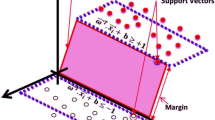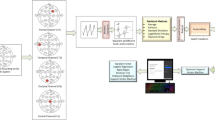Abstract
With the popularity of software-defined radio and cognitive radio-technologies in wireless communication, radio frequency devices have to adapt to changing conditions and adjust its transmitting parameters such as transmitting power, operating frequency, and modulation schemes. Thus, automatic modulation classification becomes an essential feature for such scenarios where the receiver has a little or no knowledge about the transmitter parameters. This paper presents kth nearest neighbor (KNN)-based classification of M-QAM and M-PSK modulation schemes using higher-order cumulants as input features set. Genetic programming is used to enhance the performance of the KNN classifier by creating super features from the data set. Simulation result shows improved accuracy at comparatively lower signal-to-noise ratio for all the considered modulations.

Similar content being viewed by others
References
Su W, Xu JL, Zhou M (2008) Real-time modulation classification based on maximum likelihood. IEEE Commun Lett 12(11):801–803
Poli R, Langdon WB, McPhee NF (2008) A field guide to Genetic Programming. Published via http://lulu.com
Koza JR (1992) Genetic Programming. MIT Press, Cambridge
Aslam MW, Zhu Z, Nandi AK (2012) Automatic modulation classification using combination of genetic programming and KNN. IEEE Trans Wirel Commun 11(8):2742–2750
Xu J, Su W, Zhou M (2011) Likelihood-ratio approaches to automatic modulation classification. IEEE Trans Syst Man Cybern 41(4):455–469
Dobre O, Abdi A, Bar-Ness Y, Su W (2007) Survey of automatic modulation classification techniques: classical approaches and new trends’. IET Commun 1(2):137–156
Su W (2013) Feature space analysis of modulation classification using very high-order statistics. IEEE Commun Lett 17(9):1688–1691
Hameed F, Dobre OA, Popescu DC (2009) On the likelihood-based approach to modulation classification. IEEE Trans Wirel Commun 8(12):5884–5892
Azzouz EE, Nandi AK (1998) Algorithms for automatic modulation recognition of communication signals’. IEEE Trans Commun 46(4):431–436
Wang F, Wang X (2010) Fast and robust modulation classification via Kolmogorov–Smirnov test. IEEE Trans Commun 58(8):2324–2332
Ho KC, Prokopiw W, Chan YT (2000) Modulation identification of digital signals by the wavelet transform. IEE Proc Radar Sonar Navig 147(4):169–176
Hong, L, Ho K (1999) Identification of digital modulation types using the wavelet transform. In: Proceedings of 1999 IEEE military communications conference
Zhao F, Hu Y, Hao S (2008) Classification using wavelet packet decomposition and support vector machine for digital modulations. J Syst Eng Electron 19(5):914–918
Li P, Wang F, Wang Z (2006) Algorithm for modulation recognition based on high-order cumulants and subspace decomposition. In: Proceedings of 2006 eighth international conference on signal processing
Mirarab M, Sobhani, M (2007): ‘Robust modulation classification for PSK/QAM/ASK using higher-order cumulants. In: Proceedings of 2007 sixth international conference on information, communications and signal processing
Shen L, Li S, Song S, Chen F (2006) Automatic modulation classification of MPSK signals using high order cumulants. In: Proceedings of 2006 eighth international conference on signal processing
An N, Li B, Huang M (2010) Modulation classification of higher order MQAM signals using mixed-order moments and Fisher criterion. In: Proceedings of 2010 the second international conference on computer and automation engineering
Aslam MW, Zhu Z, Nandi AK (2010) Automatic digital modulation classification using genetic programming with K-nearest neighbor. In Proceedings 2010 military communications conference, pp 512–517
Shan Z, Xin Z, Ying W (2010) Improved modulation classification of MPSK signals based on high order cumulants. In: Proceedings of 2010 2nd international conference on future computer and communication
Zhang M, Ciesielski VB, Andrea P (2003) A domain-independent window approach to multiclass object detection using genetic programming. EURASIP J Appl Signal Process 8:841–859
Zhang L, Jack L B, Nandi AK (2005) Extending genetic programming for multi-class classification by combining k-nearest neighbor. In Proceedings IEEE international conference on acoustics, speech, and signal processing pp 349–352
Hazar MA, Odabasioglu N, Ensari T, Kavurucu T, Sayan O F (2017) Performance analysis and improvement of machine learning algorithms for automatic modulation recognition over Rayleigh fading channels. Neural Comput Appl, Springer, pp 1–10
Vladimir DO, Miroslav LD (2009) Automatic modulation classification algorithm using higher-order cumulants under real-world channel conditions. IEEE Commun Lett 13(12):917–919
Subasi A, Ismail Gursoy M (2010) EEG signal classification using PCA, ICA, LDA and support vector machines. Expert Syst Appl 37(12):8659–8666
Zaerin M, Seyfe B (2012) Multiuser modulation classification based on cumulants in additive white Gaussian noise channel. IET Signal Process 6(9):815–823
Liu J, Luo Q (2012) A novel modulation classification algorithm based on daubechies wavelet and fractional In: Fourier transform in cognitive radio IEEE 14th international conference on communication technology, pp 115–120
Mühlhaus MS, Öner M, Dobre OA, Jondral FK (2013) A low complexity modulation classification algorithm for MIMO systems. IEEE Commun Lett 17(10):1881–1884
Ghauri SA, Qureshi IM, Malik AN, Cheema TA (2014) Automatic digital modulation classification technique using higher order cumulants on faded channel. J Basic Appl Sci Res 4(3):1–12
Ghauri SA, Qureshi IM, Malik AN, Cheema TA (2014) A novel modulation classification approach using Gabor filter network. Sci World J (TSWJ) pp. 1–14
Ghauri SA, Qureshi IM, Basir S, Hassam (2014) modulation classification using spectral features on fading channels. Sci Int 27:147–153
Ghauri SA, Qureshi IM, Shah I, Khan N (2014) Modulation classification using cyclo-stationary features on fading channels. Res J Appl Sci Eng Technol (RJASET) 7(24):5331–5339
Amuru SD, De-Silva RCM (2015) A blind preprocessor for modulation classification applications in frequency-selective non-Gaussian channels. IEEE Trans Commun 63(1):156–169
Ghauri SA, Qureshi IM (2015) M-PAM signals classification using modified Gabor filter network. Math Probl Eng 2015:1–10
Chang DC, Shih PK (2015) Cumulants-based modulation classification technique in multipath fading channels. IET Commun 9(6):828–835
Hussain A, Ghauri SA, Qureshi IM, Sohail MF, Khan SA (2016) KNN based classification of digital modulated signals. Int Islam Univ Malays Eng J (IIUMEJ) 17:71–82
Zhu Z, Aslam MW, Nandi AK (2010) Augmented genetic programming for automatic digital modulation classification. In: Proceedings 2010 IEEE international workshop on machine learning for signal processing, pp 391–396
Author information
Authors and Affiliations
Corresponding author
Ethics declarations
Conflict of interest
The authors declare that there is no conflict of interests regarding the publication of this paper.
Rights and permissions
About this article
Cite this article
Hussain, A., Sohail, M.F., Alam, S. et al. Classification of M-QAM and M-PSK signals using genetic programming (GP). Neural Comput & Applic 31, 6141–6149 (2019). https://doi.org/10.1007/s00521-018-3433-1
Received:
Accepted:
Published:
Issue Date:
DOI: https://doi.org/10.1007/s00521-018-3433-1




